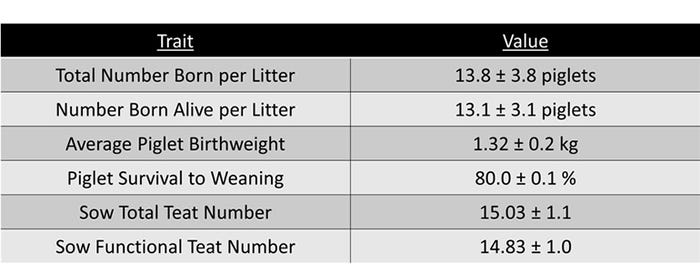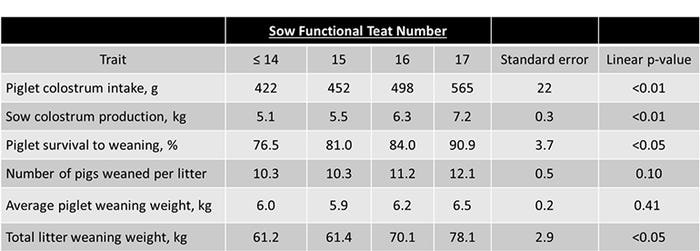Results confirm what farms with excellent piglet survival perhaps already know, the importance of having enough functional teats for each litter. Perhaps farmers would be wise to select gilts with the most teats (assuming structural confirmation is adequate).
March 8, 2018

By Jeff Wiegert, Audrey Earnhardt and Mark Knauer, North Carolina State University
Teat number is a commonly used metric to evaluate underline quality at replacement gilt selection. A minimum number of teats is typically suggested for entry into the breeding herd, yet this criterion may be forgiven when demand for gilts is high. The objective of the present study was to characterize the importance of sow functional teat number on piglet colostrum intake and litter throughput.
Second parity Landrace x Large White sows (n=59) were farrowed at the North Carolina Department of Agriculture Tidewater Research Station at Plymouth, N.C.). At birth, all piglets were individually identified and weighed prior to first suckle. Piglets were reweighed at 24 hours of age and individual piglet colostrum intake estimated using an equation incorporating birth weight, 24-hour weight gain and duration of suckling. During farrowing, sow teats were counted and sampled for functionality, defined as the ability for milk to be stripped from the teat. Weaning traits included number weaned, average 21-day piglet weight, total litter weaning weight and piglet survival. Piglet survival was calculated as number weaned divided by total number born. Descriptive statistics are shown in Table 1.

Table 1: Descriptive statistics of litter traits and sow teat number.
Results are reported in Table 2. As the number of functional teats increased, piglet colostrum intake improved (P<0.01). A one nipple increase in functional teat number improved (P<0.05) piglet survival by 3.25%, total litter weaning weight by 3.6 kilograms and tended (P=0.10) to increase number weaned by 0.34 piglets.

Table 2: Associations between sow functional teat number with litter traits.
Results confirm what farms with excellent piglet survival perhaps already know, the importance of having enough functional teats for each litter. Yet this data can perhaps be used to place an economic value on teat number during gilt selection. Perhaps farmers would be wise to select gilts with the most teats (assuming structural confirmation is adequate).
Our plan this coming summer is to greatly expand the current pilot study and evaluate the genetics of sow functional teat number. Questions can be sent to Mark Knauer or Jeff Wiegert.
The authors would like to acknowledge the North Carolina Department of Agriculture Tidewater Research Station for their continued help and support.
You May Also Like



